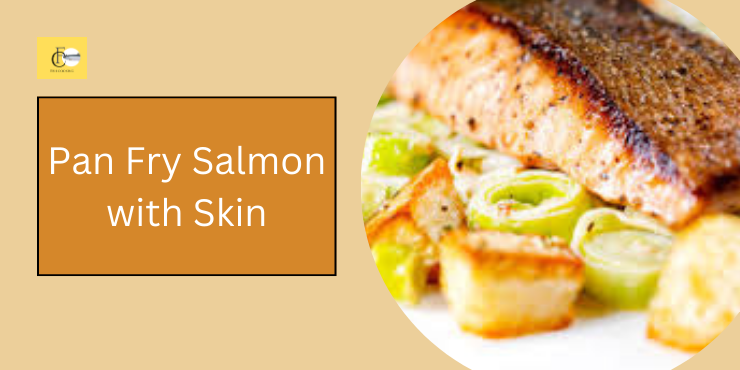Pan Fry Salmon with Skin
Pan Fry Salmon with Skin can be a culinary delight when done correctly. The crispiness of the skin combined with the tender, juicy meat inside makes for an exquisite dish that’s both healthy and delicious. In this guide, we’ll walk you through the steps to perfecting this cooking technique, ensuring you get restaurant-quality results right at home.
Choosing the Right Salmon
When it comes to salmon, the quality of your fish will significantly impact the final dish. You’ll often hear debates about wild-caught vs. farm-raised salmon. Wild-caught salmon tends to have a more robust flavor and firmer texture, whereas farm-raised salmon is often milder and fattier. Fresh salmon is always preferable, but frozen can be just as good if properly thawed.
Preparing Your Salmon
Before you even think about hitting the stove, preparation is key. Start by cleaning your salmon fillets under cold water and removing any bones. Pat the fillets dry with a paper towel—this step is crucial for achieving that crispy skin.
Seasoning the Salmon
For a flavorful salmon, basic seasoning goes a long way. A simple mix of salt, pepper, and a squeeze of lemon can enhance the natural taste of the fish. If you have time, marinate your salmon in olive oil, garlic, and herbs for 30 minutes to intensify the flavors.
Selecting the Right Pan
The type of pan you use can make or break your salmon. A heavy-bottomed pan, such as a cast iron skillet or a stainless steel pan, ensures even heat distribution, which is essential for a perfect sear.
Choosing the Right Oil
Selecting the right oil is crucial for pan-frying salmon. Oils with high smoke points, like canola oil, avocado oil, or grapeseed oil, are ideal. These oils can withstand high temperatures without burning, ensuring your salmon cooks evenly.
Prepping the Pan Fry Salmon with Skin
Heat your pan over medium-high heat until it’s hot but not smoking. Add a generous amount of oil and swirl it around to coat the entire surface. This step prevents the salmon from sticking and helps achieve a uniform crispy skin.
Cooking the Salmon: Step-by-Step Guide
- Placing the Salmon in the Pan: Lay the salmon skin-side down in the hot pan. It should sizzle immediately, indicating the pan is hot enough.
- Cooking Time and Temperature: Cook the salmon for 4-6 minutes on the skin side without moving it. This time allows the skin to become crispy.
Achieving Crispy Skin

To get that coveted crispy skin, press down gently on the salmon with a spatula for the first 30 seconds of cooking. This ensures the skin makes full contact with the pan, allowing it to crisp up nicely.
Flipping the Salmon
When the edges of the salmon turn opaque and the skin is crispy, it’s time to flip. Use a fish spatula to carefully turn the salmon over. Cook for an additional 2-4 minutes, depending on the thickness of the fillet.
Checking for Doneness
To check if your salmon is done, use a meat thermometer. The internal temperature should reach 145°F (63°C). Alternatively, you can gently press the flesh with your finger; it should be firm yet slightly springy.
Resting the Salmon
Resting your salmon after cooking allows the juices to redistribute throughout the fillet, ensuring every bite is moist and flavorful. Let the salmon rest for about 5 minutes before serving.
Serving Suggestions
Salmon pairs wonderfully with a variety of sides. Consider serving it with roasted vegetables, a fresh salad, or a light quinoa pilaf. For a gourmet touch, garnish with fresh herbs and a wedge of lemon.
Common Mistakes to Avoid
- Overcooking or Undercooking: Monitor the cooking time and internal temperature closely.
- Not Seasoning Properly: Don’t be afraid to use enough salt and other seasonings to enhance the flavor.
Conclusion
Pan-frying salmon with skin is a straightforward process that yields delicious results. By choosing the right salmon, preparing it properly, and following the steps for cooking and seasoning, you’ll create a dish that’s both impressive and delectable. Give this method a try and enjoy the delightful combination of crispy skin and tender salmon.
FAQs
How do I keep the salmon from sticking to the pan?
Ensure the pan is hot and well-oiled before adding the salmon. Patting the salmon dry and using a non-stick or well-seasoned pan also helps.
Can I use butter instead of oil for frying salmon?
Yes, but be cautious as butter has a lower smoke point and can burn easily. Consider using a mix of butter and oil to prevent this.
What are the health benefits of eating salmon?
Salmon is rich in omega-3 fatty acids, high-quality protein, and essential vitamins and minerals, making it a nutritious choice.
How do I store leftover cooked salmon?
Store leftover salmon in an airtight container in the refrigerator for up to 3 days. Reheat gently to avoid drying it out.
Can I pan fry salmon without skin?
Yes, you can. The method is similar, but you won’t achieve the crispy skin. Be sure to watch the cooking time closely to avoid overcooking.

